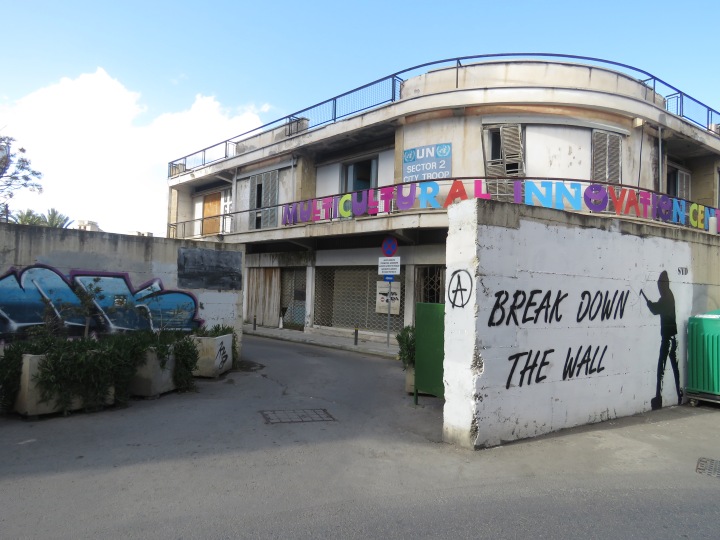
A 112-mile buffer zone separates South Cyprus from North, dividing the entire country longitudinally and cutting though the capital city of Nicosia; Nicosia, or Lefkosia if you want to speak in Greek as the Cypriots do.
The buffer zone, also known as the Green Line, was first created in 1964 and made impassable in 1974. It remained closed until 2003 at which point it was opened and allowed all to cross freely. At the time of the Turkish occupation, Greek Cypriots were forced south and Turkish Cypriots went north. A type of no-man’s land, the buffer zone is patrolled by the United Nations. Evidence of war zones gone-by still line the buffer zone. Large metal bins rusted with age, stacks of sandbags, little boxed holes just large enough to aim a rifle through and shoot on target. Protection.
After forty-two years of division Cypriots remain hopeful that one day soon, life will return as it once was.
A typical conversation with Cypriots about the subject begins and ends the same. It is a story I have heard too many times to count, most often without instigation on my part. The information I included here was collected from conversations with tour guides and residents throughout Cyprus.
Every time a Greek Cypriot speaks of the past, they do so with a triangulation of emotion: of pain, of desire, and of hope. Beginning with downturned eyes, one speaks of pain of the past and a distaste for the idea of losing his home. Even though visits are still allowed, seeing one’s home from the outside in a world that has changed around it is undesirable and therefore seldom done. Eyes slowly turning to meet his audience, the speaker then goes on to say how one day he wishes to return. That spark of hope builds quickly and soon he follows with, “and one day soon we will have a resolution and we can return back to normal.”
Every time. The same circle of hope. Someday soon.
Click on an image to browse through the gallery:







I began on the southern side of Nicosia. The capital city is surrounded by a star-shaped wall, originally built in the mid-1500s by the Venetians. Entrance into the walled area is simple and easily done without recognition. Blue and white Grecian flags are seen alongside the white and copper flag of Cyprus. Inside the old city, sky scrapers no longer take over. Instead, two story buildings with lace shops, tailors and restaurants line the streets.
Homes on the buffer zone are not allowed to have windows open to the other side’s territory. Shut off from light and from the land they once freely roamed, many of these homes have been closed for ages and wealthy families and businessmen have begun to take initiative. Purchasing properties in Old Town Nicosia, builders have retained old city charm and respected historical preservation standards whilst allowing the buildings to once again function as home, shop, or cafe. Though many still remain empty, their original owners refusing to sell to someone more ambitious, the town has a charming feel about it with unexpected bits of history mixing with modernity.
Click on an image to browse through the gallery:






A walk through border patrol is done with little questioning. Passport scanners allow visitors out of Greek Occupied Southern Cyprus, where blue and white flags fly freely, and into Turkish Republic of Northern Cyprus, where flags of red and white are found. There is no passport stamp given, yet it is a border more clearly defined than many. Once on the Turkish side, there are advertisements for Turkey’s Efes Beer instead of south Cyprus’s Keo. The island’s famous halloumi cheese becomes instead hellim. Mosques replace churches, though cities on the Greek side have each kept one functioning mosque for Muslims who wish to worship. Turkish banks replace Cyprus National banks.
I crossed to the Turkish side along with my couchsurfing host, and we stopped for a small picnic in a park with a view of the mountains. Others had set up little spots for snacks as well, and two women pushed their children on swings. It was just like any other picnic in the park. Except that we were in the Buffer Zone Peace Park. Ahead of us was a small hut painted in bold camouflage of brown, black and green. Inside was a young man in identically patterned clothing. Past the women in hijabs, a site not likely to be seen in South Cyprus, the mountains are decorated with two symbols. The Turkish Flag of white and red and the Turkish Republic of Northern Cyprus Flag of opposite decoration, red replacing white and white replacing red, are seen from far past the territories’ boundaries. All clear reminders of occupied space.
Click on an image to browse through the gallery:







There’s no escaping the realities of the island’s division and what it has done to its residents. In cities more distanced from the wall and with residents younger than the forty-odd years since the occupation, this division is spoken of less. But as both time and distance grow stronger, it’s a topic nearly inevitably discussed.
Nicosia, or Lefkosia as the Cypriots refer to it, is the only capital city in the world which remains divided today. Someday soon life will return as it once was, ask anyone.


One thought on “Nicosia Cyprus: The Last Capital Divided”